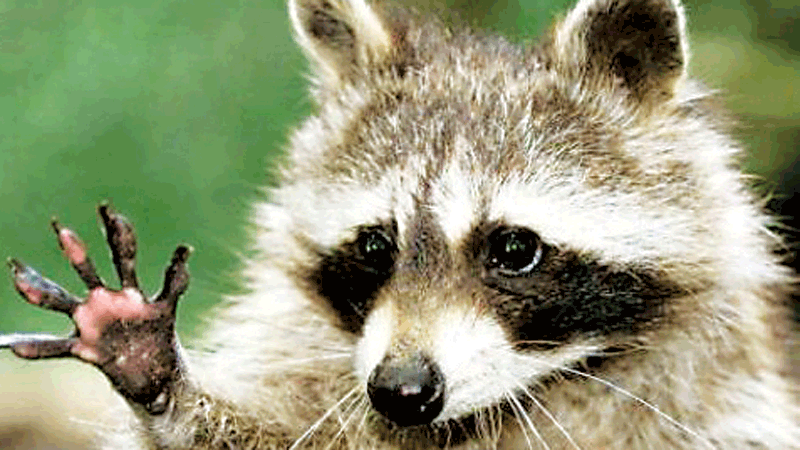RACCOONS ARE POPULAR – Life In The Outdoors
 Black mask across its eyes, small head, pointed nose and ears, bushy tail with black rings, no animal in North America is more distinctively marked, more easily recognized than a raccoon. It’s also one of the most widespread animals of North America. Its range is from southern Canada south through Florida and the Gulf Coast states and into Mexico and from the Atlantic Coast to the Pacific Coast.
Black mask across its eyes, small head, pointed nose and ears, bushy tail with black rings, no animal in North America is more distinctively marked, more easily recognized than a raccoon. It’s also one of the most widespread animals of North America. Its range is from southern Canada south through Florida and the Gulf Coast states and into Mexico and from the Atlantic Coast to the Pacific Coast.
Raccoons are also common though they are not commonly seen. They are nocturnal, animals of the night, and of woodlands and forests. But two raccoons visited the bird feeder outside my dining room window several nights last spring. I saw them when I went to the door and let the dog out in the evening, after dark, before going to bed. I don’t know where they came from. I live in the country but not in a forest. There is a wooded area across the road.
Raccoons are good climbers and they are game animals. Hunters use dogs to locate them. They are not fast and when a dog, or a pack of dogs gets on the trail of one, after a short pursuit it goes up a tree where the hunter can pick it off with his gun.
In addition to forested land, raccoons like water. They are often seen wading along streams and rivers and around the margins of lakes, dabbling in the water, catching crayfish, frogs and small fish. Seen frequently sloshing prey about in the water, it is often said that raccoons wash their prey.
I’ve seen four coons, as they are often called, during the day recently. Not together and all dead, lying along the side of the highway near my home.
There are two times of the year when coons wander greatly, sometimes for a considerable distance. One, which was captured, radio-tagged and released, was recaptured 58 miles from where it had been tagged.
Beginning in late summer and extending into the early fall, now, is one of those times when many raccoons are particularly mobile. It’s the time when families are breaking up, when young raccoons are leaving their mother and litter mates, setting out on their own.
The other time raccoons wander more than their usual nightly perambulations is in late winter and early spring, the time of mating. Then it’s the adults that do the wandering, particularly the males. Mating is in February or March and the young are born in April or May. The average litter size is four or five but I read it may be as many as nine.
Raccoons hole up. When not wandering they take shelter in hollows in trees, in hollow logs and in caves. Their young are born in those dens. There raccoons also take shelter from inclement weather, heavy rain or snow and cold. But they don’t hibernate. They frequently stay in a den for several days in winter, fasting, sleeping deeply, but then they’ll be out and about, prowling, searching for food, eating, replenishing the winter fat supply.
Raccoons are omnivorous. They eat almost anything edible, grain, nuts, fruit. They eat grasshoppers and other insects. They raid bird nests and eat eggs and nestlings. To the displeasure of farmers, they kill and eat chickens and their eggs. They are especially fond of corn in the milk stage, days before it is considered ready to harvest. A raccoon or two or more in a corn field is a disaster. Several raccoons will strip the ears from the stalks and lay waste to an acre or more of corn in a night.
In spite of their depredations on fruit, corn, chickens and eggs, raccoons are popular animals. Their masked face gives them a mischievous look and many people like seeing a coon. I do, and I felt a twinge of sadness at each one I saw by the road recently.
- Birds As Weather Forecasters – Life In The Outdoors - December 17, 2021
- Rare Bird Spotted In Indiana – Life In The Outdoors - October 8, 2021
- MY EXPERIENCE WITH DEER – Life In The Outdoors - July 30, 2021


